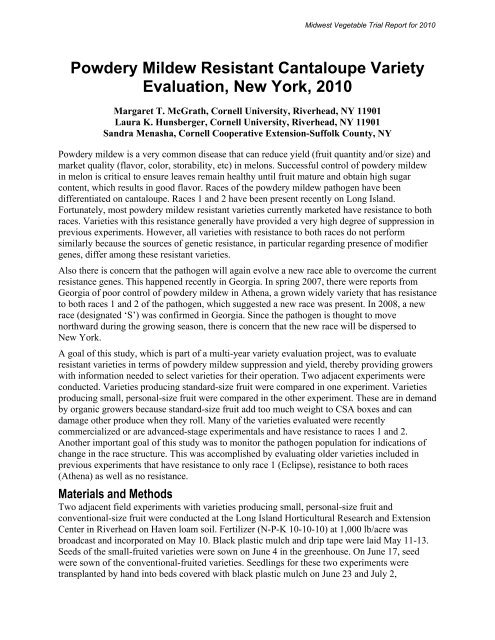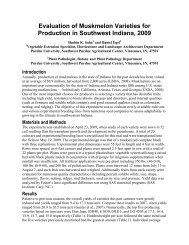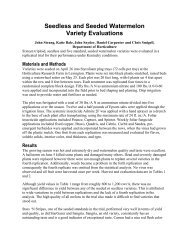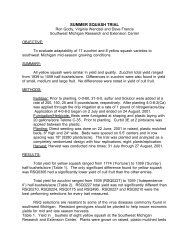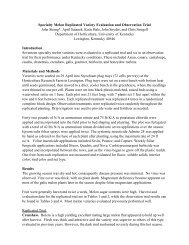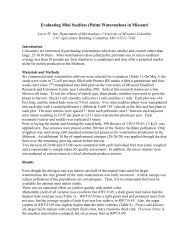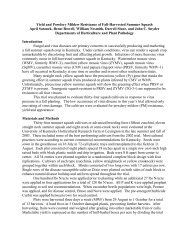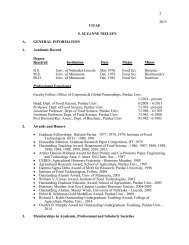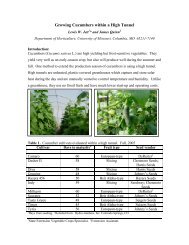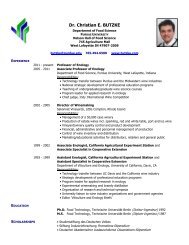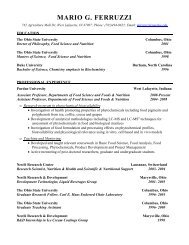Powdery Mildew Resistant Cantaloupe Variety Evaluation, New ...
Powdery Mildew Resistant Cantaloupe Variety Evaluation, New ...
Powdery Mildew Resistant Cantaloupe Variety Evaluation, New ...
Create successful ePaper yourself
Turn your PDF publications into a flip-book with our unique Google optimized e-Paper software.
Midwest Vegetable Trial Report for 2010<br />
<strong>Powdery</strong> <strong>Mildew</strong> <strong>Resistant</strong> <strong>Cantaloupe</strong> <strong>Variety</strong><br />
<strong>Evaluation</strong>, <strong>New</strong> York, 2010<br />
Margaret T. McGrath, Cornell University, Riverhead, NY 11901<br />
Laura K. Hunsberger, Cornell University, Riverhead, NY 11901<br />
Sandra Menasha, Cornell Cooperative Extension-Suffolk County, NY<br />
<strong>Powdery</strong> mildew is a very common disease that can reduce yield (fruit quantity and/or size) and<br />
market quality (flavor, color, storability, etc) in melons. Successful control of powdery mildew<br />
in melon is critical to ensure leaves remain healthy until fruit mature and obtain high sugar<br />
content, which results in good flavor. Races of the powdery mildew pathogen have been<br />
differentiated on cantaloupe. Races 1 and 2 have been present recently on Long Island.<br />
Fortunately, most powdery mildew resistant varieties currently marketed have resistance to both<br />
races. Varieties with this resistance generally have provided a very high degree of suppression in<br />
previous experiments. However, all varieties with resistance to both races do not perform<br />
similarly because the sources of genetic resistance, in particular regarding presence of modifier<br />
genes, differ among these resistant varieties.<br />
Also there is concern that the pathogen will again evolve a new race able to overcome the current<br />
resistance genes. This happened recently in Georgia. In spring 2007, there were reports from<br />
Georgia of poor control of powdery mildew in Athena, a grown widely variety that has resistance<br />
to both races 1 and 2 of the pathogen, which suggested a new race was present. In 2008, a new<br />
race (designated ‘S’) was confirmed in Georgia. Since the pathogen is thought to move<br />
northward during the growing season, there is concern that the new race will be dispersed to<br />
<strong>New</strong> York.<br />
A goal of this study, which is part of a multi-year variety evaluation project, was to evaluate<br />
resistant varieties in terms of powdery mildew suppression and yield, thereby providing growers<br />
with information needed to select varieties for their operation. Two adjacent experiments were<br />
conducted. Varieties producing standard-size fruit were compared in one experiment. Varieties<br />
producing small, personal-size fruit were compared in the other experiment. These are in demand<br />
by organic growers because standard-size fruit add too much weight to CSA boxes and can<br />
damage other produce when they roll. Many of the varieties evaluated were recently<br />
commercialized or are advanced-stage experimentals and have resistance to races 1 and 2.<br />
Another important goal of this study was to monitor the pathogen population for indications of<br />
change in the race structure. This was accomplished by evaluating older varieties included in<br />
previous experiments that have resistance to only race 1 (Eclipse), resistance to both races<br />
(Athena) as well as no resistance.<br />
Materials and Methods<br />
Two adjacent field experiments with varieties producing small, personal-size fruit and<br />
conventional-size fruit were conducted at the Long Island Horticultural Research and Extension<br />
Center in Riverhead on Haven loam soil. Fertilizer (N-P-K 10-10-10) at 1,000 lb/acre was<br />
broadcast and incorporated on May 10. Black plastic mulch and drip tape were laid May 11-13.<br />
Seeds of the small-fruited varieties were sown on June 4 in the greenhouse. On June 17, seed<br />
were sown of the conventional-fruited varieties. Seedlings for these two experiments were<br />
transplanted by hand into beds covered with black plastic mulch on June 23 and July 2,
Midwest Vegetable Trial Report for 2010<br />
respectively, both one day after a waterwheel transplanter was used to open the holes and apply<br />
starter fertilizer plus insecticide. During the season, water was provided as needed via drip<br />
irrigation lines located beneath the mulch. Additional fertilizer (N-P-K 46-0-0) at 30 lb/acre was<br />
injected through the drip irrigation system twice.<br />
Weeds were controlled between the rows of black plastic mulch by applying a tank mix of<br />
Strategy ® (3 pt/acre), Sandea ® (0.5 oz/acre), and Roundup ® (16 fl oz/acre) on June 7; with Select<br />
2EC ® (8 oz/acre) with 1% COC on July 20 to control grass weeds; and by hand weeding. Select ®<br />
was applied when air temperature was at least 85 ° F and damaged foliage. Cucumber beetles were<br />
managed with AdmirePro ® applied with the transplanter and Asana XL ® (9.6 oz/acre) applied to<br />
foliage on July 23. No fungicides were applied to control powdery mildew. The following<br />
fungicides were applied preventively for downy mildew (Pseudoperonospora cubensis) and<br />
Phytophthora blight (Phytophthora capsici): ProPhyt ® (3 qt/acre) on July 21; Ranman 400SC ®<br />
(2.75 fl oz/acre) on August 7; Forum ® (6 fl oz/acre) on August 14 and 21; and Tanos ® (8 oz/acre)<br />
on August 28.<br />
Plots were three adjacent rows each with four plants spaced 24 inches apart. Rows were spaced<br />
68 inches apart. Two plants of Multipik, a susceptible summer squash variety, were planted<br />
between each plot in each row to separate plots and provide a source of inoculum. A randomized<br />
complete block design with four replications was used.<br />
Upper and lower leaf surfaces were assessed for powdery mildew on August 19. <strong>Powdery</strong><br />
mildew colonies (spots) were counted, and severity was estimated when colonies had coalesced<br />
or were too numerous to count. Colony counts were converted to severity values using the<br />
conversion factor of 30 colonies/leaf=1%.<br />
Yield assessments were done on August 9, 16, 24, and 30 for the small-fruited varieties, and on<br />
August 24 and 30 for the conventional-fruited varieties. Ripe fruit were harvested and weighed.<br />
Many fruit were unmarketable at each harvest date because they had over-ripened; therefore,<br />
total yield for each plot was estimated using total fruit count and average fruit weight of<br />
marketable fruit. Characteristics of marketable fruit were also evaluated. Overall appearance was<br />
rated on a scale of 1 to 9, with 1=poor and 9=best.<br />
Average monthly high and low temperatures (°F) were 73/58 in June, 80/64 in July, and 83/68 in<br />
August. Rainfall (inches) was 6.43, 4.82, and 2.01 for these months, respectively.<br />
Results and Discussion<br />
Most of the powdery mildew resistant melon varieties evaluated in 2010 have resistance to<br />
pathogen races 1 and 2. An older variety with resistance only to race 1, Eclipse, was included to<br />
assess the value of resistance to race 2. Most varieties are cantaloupe types. Arava is a galia type<br />
and Sivan is a charentais type. The varieties included nine that produce small, personal-size fruit<br />
and six that produce conventional-size fruit. Organic growers marketing through CSAs have<br />
indicated that powdery mildew resistant varieties producing small fruit are desirable because<br />
these do not add an unacceptable amount of weight to produce boxes and are less likely when<br />
they roll to damage other produce in the box compared to conventional-size fruit.<br />
Most of the resistant melon varieties producing personal-size fruit did not effectively suppress<br />
powdery mildew while those with conventional-size fruit were moderately effective, providing<br />
69-89% suppression of powdery mildew on upper leaf surfaces and 70-95% control on lower<br />
(Table 1). Among the small-fruited varieties, powdery mildew was significantly less severe than
Midwest Vegetable Trial Report for 2010<br />
the susceptible variety on upper leaf surfaces of Lil’ Loupe (53% control) and on lower surfaces<br />
of Arava (75%). All resistant varieties had numerically less severe powdery mildew than<br />
Passport. Diva is not advertised as having resistance; however, results from this experiment and<br />
an experiment conducted in 2009 indicate that it does. The difference between the two melon<br />
groups may be partly due to the timing of the one assessment that was done. Since the first group<br />
was seeded about two weeks before the second, the plants were in the middle of the harvest<br />
period when assessed on August 19, while harvest had not yet begun for the second group.<br />
<strong>Powdery</strong> mildew typically begins to develop during fruit production. Severity of powdery<br />
mildew on all these varieties in 2010 was substantially greater than in 2009 and 2008 when<br />
similar experiments were conducted with many of the same varieties. On August 25, 2009,<br />
which was one week after the first harvest, very few symptoms of powdery mildew were found<br />
on the resistant varieties with none found on leaves of Eclipse or Strike, and severity well below<br />
1% on the others, while severity was 20% and 16% on upper and lower leaf surfaces,<br />
respectively, of Superstar and 1.7% and 2.5% for Passport. On August 15, 2008, severity was<br />
well below 1% for varieties with resistance to race 1 and 2, 5% and 34% for Eclipse, and 40%<br />
and 50% for Superstar. Results from these experiments suggest that a new race was present on<br />
Long Island in 2010. Races 1, 2, and 3 of the cucurbit powdery mildew fungus (Podosphaera<br />
xanthii) were present in 2010 with race 1 the dominant race based on severity of powdery<br />
mildew on the differentials (Hale’s Best Jumbo, PMR 45, PMR 5, and MR 1) in a nearby<br />
planting. There were reports of powdery mildew becoming severe in commercial fields in <strong>New</strong><br />
York in 2010.
Midwest Vegetable Trial Report for 2010<br />
Table 1. Suppression of powdery mildew and yield for cantaloupe varieties producing personalsize<br />
and standard-size fruit (section 2). Comparison done on Long Island, NY, in 2010. Varieties<br />
with race 1 and 2 resistance are listed based on disease control with best first.<br />
<strong>Variety</strong> (resistance) 1<br />
Seed<br />
Sources 2<br />
<strong>Powdery</strong> <strong>Mildew</strong><br />
Severity (%) 3<br />
Upper<br />
Leaf<br />
Surface<br />
Lower<br />
Leaf<br />
Surface<br />
Estimated Total Fruit Yield<br />
Number/<br />
Plant<br />
Weight/<br />
Plant (lb)<br />
Weight/<br />
Fruit (lb)<br />
Personal-size Fruit<br />
Lil’ Loupe (R1,2) H 34.19 b 4 18.19 ab 5.3 ab 12.0 a 2.2 cd<br />
Arava (R1,2) HMO 38.00 ab 15.30 b 3.1 cde 11.2 ab 3.7 a<br />
HSR 4402 (R1,2) HL 40.88 ab 31.43 ab 3.1 cde 7.5 cd 2.5 bcd<br />
HSR 4307 (R1,2) HL 47.80 ab 25.30 ab 6.2 a 10.4 abc 1.7 d<br />
Head Start (R1,2) OUT 51.53 ab 26.58 ab 4.5 bc 11.7 a 2.6 bc<br />
HSR 4370 (R1,2) HL 63.75 ab 37.35 ab 3.8 bcd 7.7 bcd 2.0 cd<br />
Sugar Cube (R1,2) H 60.85 ab 43.50 ab 4.0 bc 10.5 abc 2.6 bc<br />
Pixie (R1,2) HL 63.40 ab 44.85 ab 3.7 bcd 8.1 bcd 2.2 cd<br />
Sivan (R1,2) HMO 67.18 ab 41.88 ab 2.3 de 7.3 cd 3.2 ab<br />
Passport (S) HL 73.20 a 61.20 a 1.7 e 6.1 d 3.6 a<br />
P-value (treatment) 0.0153 0.0386
Midwest Vegetable Trial Report for 2010<br />
Table 2. Fruit characteristics of cantaloupe varieties compared on Long Island, NY, in 2010. The<br />
last entry in each section is the standard, susceptible variety included for comparison. Varieties<br />
are listed based on taste with best first.<br />
<strong>Variety</strong><br />
Length<br />
(in.)<br />
Width<br />
(in.)<br />
Fruit Quality Assessments 1<br />
Cavity<br />
Color<br />
Brix (%<br />
sucrose)<br />
Taste Rib Net<br />
Personal-size Fruit<br />
HSR 4370 5.16 5.05 7.0 5.5 8.8 7.0 1.0 3.0<br />
Pixie 5.27 5.27 6.0 7.0 11.8 6.5 1.0 4.5<br />
HSR 4307 6.31 5.85 7.0 7.5 11.3 6.5 1.0 7.5<br />
HSR 4402 6.18 5.77 4.5 6.0 10.5 6.5 4.3 7.0<br />
Sugar Cube 5.36 5.13 7.3 7.5 10.5 6.5 2.0 7.5<br />
Lil’ Loupe 4.73 4.78 6.0 8.0 11.0 5.8 6.0 7.5<br />
Arava 6.26 6.63 3.0 5.5 8.5 5.0 1.0 6.5<br />
Sivan 5.83 5.63 4.0 6.0 9.0 4.5 4.5 8.0<br />
Head Start 5.56 5.23 5.5 3.5 7.5 3.8 7.0 2.0<br />
Passport (S) 5.76 5.90 6.3 4.8 7.3 3.5 1.0 2.5<br />
Standard-size Fruit<br />
Athena 6.50 7.00 5 6 9 7.5 3 8<br />
Superstar (S) 8.25 7.00 5 8 7 7 6 8<br />
Wrangler 8.25 6.25 7 7 6.5 7 2 7<br />
Diva (S) 7.00 6.25 6 6.5 5 7 3 7<br />
Eclipse 6.00 5.00 6.5 7.5 8 6.5 8 7<br />
Rockstar 7.00 6.00 7 6 5.5 6 1 3<br />
Grand Slam 7.75 6.75 4 7 5 5 3 7<br />
Goddess 6.50 5.25 4 4 4 5 7 6<br />
1 Seed cavity: 1-9 rating. 1=large and little flesh, 9=closed.<br />
Flesh color: 1-9 rating. 1=pale, 9=deep.<br />
Ribbing: 1-9 rating. 1=none, 9=heavy.<br />
Netting: 1-9 rating. 1=little, 9=excellent (western shipper).<br />
Acknowledgments<br />
This project was funded by the Friends of Long Island Horticulture Grant Program. Seed were<br />
donated by companies listed in Table 1. Pesticides were donated by BASF Corporation, Bayer<br />
CropScience, DuPont Crop Protection, FMC Corporation, Gowan Company, Helena Chemical<br />
Company, Monsanto Company, and Valent USA Corporation.


